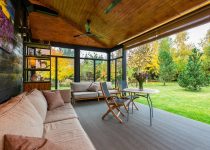Crafting DIY Wildlife Shelters in Your Backyard
Looking to bring more wildlife into your backyard? Get ready to roll up your sleeves and embark on an exciting DIY adventure!
In this article, we’ll show you how to create your very own wildlife shelters right in your own backyard. From birdhouses to bat boxes, hedgehog hideouts to butterfly sanctuaries, and bee hotels, these projects will not only provide safe havens for various creatures but also add a touch of natural beauty to your outdoor space.
So grab your tools and let’s get started!
Table of Contents
Birdhouses: Providing a Safe Haven
Build birdhouses to create a safe haven for our feathered friends in your backyard. By providing birdhouses, you’re giving birds a place to rest, nest, and raise their young. These shelters offer protection from harsh weather conditions, predators, and other threats. Plus, they add a touch of beauty and charm to your outdoor space.
When building birdhouses, keep in mind the specific needs of the birds in your area. Different species have different requirements, such as the size and shape of the entrance hole, the size of the interior, and the height at which the birdhouse should be mounted. Research the types of birds that frequent your region, and tailor your birdhouses accordingly.
To ensure the safety of the birds, use non-toxic materials and avoid using treated wood or harmful chemicals. Make sure the birdhouses have proper ventilation and drainage to prevent mold and moisture buildup. Regularly clean and maintain the birdhouses to keep them in good condition.
Remember to place the birdhouses in a quiet and secluded area, away from high traffic and potential disturbances. Provide nearby food sources, such as bird feeders and water baths, to attract more birds to your backyard.
Building birdhouses is a rewarding and enjoyable activity that not only benefits the birds but also adds a sense of fulfillment and harmony to your outdoor space. So grab your tools and start creating a safe haven for our feathered friends today!
Bat Boxes: Encouraging Nocturnal Residents
To further enhance the wildlife habitat in your backyard, consider installing bat boxes to encourage the presence of nocturnal residents. Bats are incredibly beneficial creatures that help control insect populations and pollinate plants. By providing them with a safe and comfortable shelter, you can attract these fascinating creatures to your yard.
Bat boxes, also known as bat houses, are specifically designed structures that mimic the natural roosting sites of bats. They offer a secure space for bats to rest and raise their young. Installing bat boxes in your backyard provides a habitat for these nocturnal residents and contributes to the overall biodiversity of your ecosystem.
When choosing a bat box, make sure it’s made of untreated wood and has a rough interior surface. This will allow bats to easily cling and roost. Position the box in a location that receives at least six hours of direct sunlight, preferably on a pole or the side of a building. Avoid placing it near bright lights, as this can disrupt the bats’ natural behaviors.
Once you have installed the bat box, be patient. It may take some time for bats to discover and use the new shelter. However, with a little patience and persistence, you can create a welcoming environment for these incredible creatures and enjoy the benefits they bring to your backyard.
Hedgehog Hideouts: Creating Cozy Retreats
To create a cozy retreat for hedgehogs in your backyard, consider using natural materials and providing ample hiding spots. Hedgehogs are nocturnal creatures that require a safe and comfortable place to rest during the day. By building a hedgehog hideout, you can help these adorable spiky mammals feel protected and secure.
Start by using natural materials such as logs, branches, and leaves to create a shelter. Place the logs in a pile and arrange the branches on top to create a roof. This will provide a warm and snug space for hedgehogs to nestle into. Make sure to leave a small entrance for the hedgehogs to crawl through.
Additionally, consider providing ample hiding spots within your backyard. Hedgehogs love to hide in dense vegetation, so plant bushes and shrubs that can serve as hiding places. You can also create small tunnels using rocks or wooden boards to create more hiding spots.
Remember to keep your hedgehog hideout clean and free from any potential hazards. Check for any sharp objects or chemicals that could harm the hedgehogs. Also, keep an eye out for any predators that may pose a threat to the hedgehogs.
Creating a cozy retreat for hedgehogs in your backyard is a wonderful way to support local wildlife. With a little effort and creativity, you can provide a safe and comfortable home for these adorable creatures.
Butterfly Sanctuaries: Attracting Colorful Visitors
Attract colorful visitors to your backyard by creating butterfly sanctuaries that build upon the natural materials and hiding spots used for hedgehog hideouts. Butterflies aren’t only beautiful to look at, but they also play a vital role in pollination. By providing them with a safe and inviting space, you can help support their populations and enhance the beauty of your outdoor space.
Here are four simple steps to create a butterfly sanctuary in your backyard:
-
Plant butterfly-friendly flowers: Choose nectar-rich flowers that attract butterflies, such as zinnias, marigolds, and coneflowers. These flowers provide a food source for adult butterflies and attract them to your sanctuary.
-
Provide host plants: Different butterfly species have specific host plants on which they lay their eggs. Research which butterflies are native to your area and plant their preferred host plants. For example, monarch butterflies lay their eggs on milkweed plants.
-
Create a water source: Butterflies need water to drink and stay hydrated. Place a shallow dish filled with water in your sanctuary, and add a few pebbles or twigs for butterflies to perch on while they drink.
-
Avoid pesticides: Pesticides can harm butterflies and other beneficial insects. Instead, opt for natural pest control methods, such as companion planting or handpicking pests.
Bee Hotels: Supporting Pollinators’ Habitat
Continue to enhance the pollinator-friendly environment in your backyard by creating bee hotels that provide habitat and support for these important insects. Bee hotels are artificial structures designed to mimic the natural nesting habitats of solitary bees. Solitary bees, such as mason bees and leafcutter bees, play a crucial role in pollinating plants, including many of the fruits and vegetables we rely on for food. By providing them with suitable nesting sites, you can help increase their population and ensure a thriving ecosystem.
To create a bee hotel, start by finding a sturdy wooden frame or a hollow tube made of bamboo or reeds. Cut the materials into different lengths, ensuring that they’re clean and free from any debris. Bundle them together tightly and secure them with wire or twine. Hang the bee hotel in a sunny spot, preferably facing south or southeast, to provide warmth and protection. Make sure to place it at least three feet off the ground to keep it safe from predators.
Maintaining a bee hotel is relatively simple. Clean out the nesting tubes at the end of each season to prevent the buildup of pests or diseases. Replace any damaged or worn-out materials to ensure a safe and comfortable nesting environment for the bees.
By creating a bee hotel in your backyard, you aren’t only providing a safe haven for solitary bees but also supporting the overall health of your garden. These industrious insects will repay you with their pollination services, ensuring the abundant growth of your plants and flowers.
Frequently Asked Questions
How Can I Attract Specific Bird Species to My Birdhouse?
To attract specific bird species to your birdhouse, you can provide the right nesting materials, food, and water sources. Research the preferences of the birds you want to attract and tailor your birdhouse accordingly.
Are There Any Specific Materials That Should Be Avoided When Building a Bat Box?
Avoid using treated wood or metal when building a bat box. These materials can be harmful to bats. Stick to untreated wood and make sure the box is large enough and has proper ventilation.
What Are Some Common Predators of Hedgehogs and How Can I Protect Them?
Hedgehogs face threats from predators like foxes, badgers, and dogs. To protect them, create a safe environment by removing potential hiding places for predators and providing secure shelters like hedgehog houses.
How Can I Create a Butterfly-Friendly Environment in My Backyard?
To create a butterfly-friendly environment in your backyard, plant a variety of nectar-rich flowers and provide shallow water sources. Avoid using pesticides and allow some areas of your yard to grow wild for caterpillars to feed on.
What Types of Bees Are Most Likely to Use a Bee Hotel and How Can I Attract Them?
To attract bees to a bee hotel, provide nesting materials like bamboo or hollow stems. Common types of bees that may use a bee hotel include mason bees, leafcutter bees, and sweat bees.



